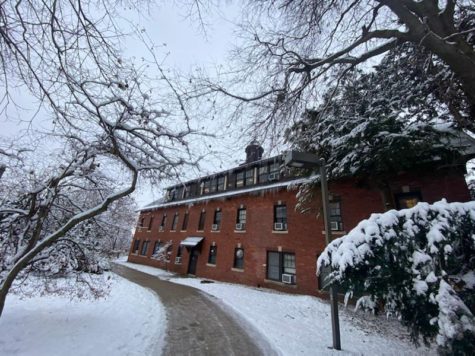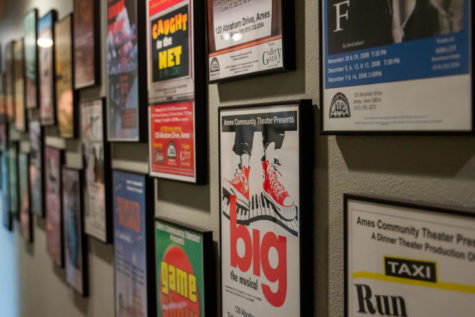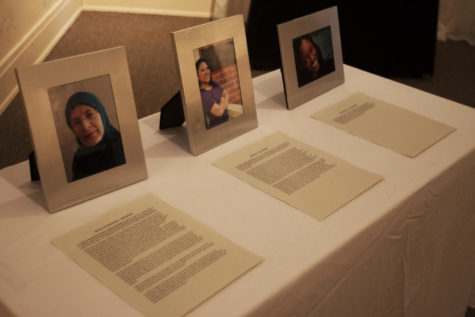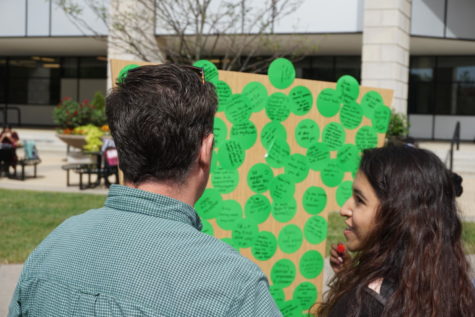Creating a Legacy: Stacy Frese, Bill Fennelly etch names into ISU women’s basketball history
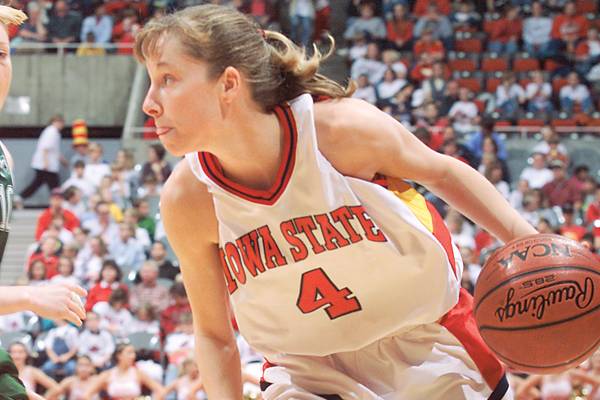
ISU guard Stacy Frese drives toward the lane in an exhibition game Nov. 4, 1998 ,versus Gija Marijampole — a team from Lithuania. File Photo: Iowa State Daily
December 14, 2015
ISU women’s basketball legend Stacy Frese walked out into the surrounding expanse of Hilton Coliseum during the 1995-96 basketball season.
She didn’t enter with any of her future Cyclone teammates, though.
Frese played basketball for Iowa at the time, but she came to watch her sister, Brenda, who was an assistant coach with ISU women’s basketball team.
A wide-eyed freshman just breaking into college basketball, Frese sat right behind “Wyld Bill,” an ISU women’s basketball fans known for his crazy antics at each game — home or away.
“Out of every seat in the arena, I had to pick this one,” Frese thought.
She took her eyes off the enthusiastic fan, attempting to block out his voice, which seemed to span the entire coliseum. She looked around.
Frese noticed just how many seats she could’ve chosen.
“There was nobody in the gym,” Frese said.
Only about 300 people filled the 14,020 cardinal-colored seats that spread across Hilton.
The small clusters of fans in the arena that day probably didn’t anticipate how quickly that would change.
In Bill Fennelly’s first year as head coach, nobody, not even Frese, knew how much the ISU women’s basketball team would grow in just a four-year span.
Bred to shoot
Frese’s dad must have known that she was destined to shoot the long ball.
She remembers the driveway where she used to hone her 3-point shooting skill. Her dad flattened the gradual slope but only in one spot — right at the top of the key.
Frese stood at that spot forever during her childhood. She would dribble the ball a few times, her eyes fixed on the basket straight in front of her, then she would jump and put the ball through the net over and over and over.
The position on the court, right at the top of the key, was her sweet spot — the spot where she wore out the net with the same shot until she left for college.
It was how she became one of the best 3-point shooters in Iowa State history.
But there was a method to her madness in endlessly practicing the shot.
Frese recognized at an early age that she wasn’t the strongest player on the court, nor the fastest, nor the tallest. But there was one aspect of basketball that she excelled at.
“[Shooting] was something that I could control,” Frese said. “You can’t control how fast you are or how strong. You can to a point, but you’re born with that or you’re not.”
Frese’s 3-point shooting practice would pay off, eventually making her an essential cog in Fennelly’s offense at Iowa State.
Humble beginnings
While Fennelly explains his beginning at Iowa State in 1995, he still points to the original box score from his first game as head coach. The rugged edges of the paper sits in a frame hanging just to the right of Fennelly’s desk.
The outcome: an 82-55 victory against Idaho State. The attendance: 310 people.
When Fennelly arrived at Iowa State in 1995, fresh off a successful tenure at Toledo, the ISU women’s basketball program struggled to find success, and it showed in the attendance numbers.
“I guess that’s why the job was open,” Fennelly said.
Fennelly and his wife, Deb, started a grassroots campaign in Iowa. They marketed and changed the culture around the team. He reached out to spread his vision for the future of the program.
Fennelly spoke to groups as small as five or as big as 1,000 — to anyone who was willing to listen.
After his first season in which he won 17 of 27 games — one less win than his predecessor had in the three previous seasons combined — people were willing to do just that.
“We had some success early,” Fennelly said. “I think that our kids started to understand, ‘Hey, OK. This is something that we can do.’”
Part of that message was stressing to his players that he wasn’t creating a five-year plan. He wanted success right away.
Fennelly preached to recruits that they could be a part of developing something special, taking part in the first generation of successful ISU women’s basketball.
“We had to find people who believed in people who had a vision,” Fennelly said. “We didn’t have a history to show them, so we had to sell vision and talk about the possibility, and luckily we found a few kids that could do that.”
But there was one player that he and his coaching staff, particularly his assistant Brenda, kept their eyes on while recruiting. She was a freshman from Cedar Falls, Iowa, who could shoot the three as well as anybody for the University of Iowa.
Iowa girl, born and raised
There wasn’t any doubt in Frese’s mind about where she wanted to transfer to when head coach Vivian Stringer left the Iowa women’s basketball program for Rutgers.
Stringer was the reason why Frese chose the Hawkeyes over other teams in the first place.
Her sister was an assistant coach at Iowa State. Fennelly, just starting to recruit the building blocks for a team that could hold a future, ran an offense that was almost tailor-made for Frese’s skill set.
Fennelly constructed his offense around speed and shooting, especially the 3-point shot — Frese’s strong suit.
It also helped that Frese had her sister nearby and meshed with Fennelly right away.
“I think he was just easier to talk to,” Frese said. “We had a lot in common. We just hit it off.”
Frese was one of the first dominoes, as Fennelly calls them, to fall and create an atmosphere that would lead to the program’s future success.
She was the perfect storm.
“It’s one of those things where certain people come along in your life and really change things,” Fennelly said. “And Stacy changed this program probably forever.”
Taking time off for the better
Frese walked back onto the court at Hilton Coliseum where she watched her sister coach just a year before. But, once again, it wasn’t in an ISU uniform.
She was in her street clothes.
Because of NCAA transfer rules, Frese had to sit out the entire 1996-1997 season.
“The games were not fun because you want to be on the court and be a part of all that,” Frese said.
In the year off, Frese was able to improve her game in ways that were not possible before. Just like when she was growing up, Frese wasn’t the biggest or fastest player on the team.
That year allowed her to grow — physically and mentally.
Frese also participated on the scout team, taking on the role of the opponent’s best player. Although she never played competitively, the season off may have been her best yet.
“I just practiced, played hard and did my thing,” Frese said.
“I never had a bad game that whole year.”
A well-oiled machine
When Fennelly thinks back to the teams he built in the 1998-2000 seasons, one thing comes to his mind first.
“The fit of players, and the fit of personalities was maybe unlike any other group that we’ve had here,” Fennelly said.
Just as Fennelly named Frese the perfect fit when she arrived at Iowa State, he also clamored about how his whole team was a perfectly cogged machine that ran on trust and dedication.
Along with Frese came Monica Huelman. Then came Megan Taylor the next year and Angie Welle the next.
It wasn’t as if other women’s basketball teams around the nation weren’t recruiting talent, though. What separated this influx of talent from others was the exceptional chemistry that came with it.
“We’ve never had a team — and we’ll never have a team — that was this close off the court and continues to be,” Fennelly said. “And I think that connection where they truly, truly cared about one another, made them a better team, and I think that’s very unique.”
The chemistry carried onto the hardwood.
“[Chemistry matters] in a team sport especially, when you know your teammate is going to work their butt off and do everything they can to have your back,” Frese said. “Just playing hard for each other. That makes a huge difference.”
The team lived up to the test time and time again, making NCAA tournament appearances in each season from 1996 to 1998.
It was put to a bigger test during a Sweet 16 matchup in 1999.
The win
Fennelly remembers two things from March 20, 1999.
The Cyclones were set to play No. 1 Connecticut in Iowa State’s first-ever Sweet 16 appearance. Only five teams faced the Huskies that season and left with a win.
But this day was special.
The game was set for the early morning in Cincinnati, Ohio. Fennelly walked out of the locker room and was stopped by a security guard, the same one who had followed the team throughout the tournament.
“He said, ‘Coach, if loose is good, I think you are in good shape,’” Fennelly said. “I don’t know why, but that stuck with me forever. “
The team certainly played loose, and not in a good way.
“We actually didn’t play that great,” Fennelly said. “But we hung around.”
Iowa State stayed within six points with just less than 5 minutes remaining in the second half.
Huelman shot a high-arching 3-pointer that sailed through the net flawlessly. Then Tracy Gahan netted one. Frese hit one.
As quickly as the scoreboard ticked off seconds, the Cyclones came roaring back.
Two more successful 3-point shots later, and the Cyclones found themselves in the lead during the fleeting minutes of the game.
That’s when Fennelly’s second memory enters.
Connecticut narrowly made the Sweet 16. In its previous game against Xavier, the Huskies trailed most of the way, but they charged back and moved on to the next round.
“[Xavier] could have knocked them out, but they didn’t,” Fennelly said. “Not even saying a word, the players were like, ‘We’re going to finish this. We’re going to finish this.’”
Not only did the Cyclones hold on for one of the biggest wins in program history, it also marked the beginning of the program as a national powerhouse.
Fennelly’s hard work to build the program from the ground up combined with Frese and her teammates playing their hearts out, paid off.
“A lot of people who followed our program say that’s the signature win,” Fennelly said. “I don’t really buy into that a whole lot, but that would be it.”
Legacy left untouched
Frese stepped out of the locker room near the end of the 1999-2000 season as a senior. Her time was drawing to an end at Iowa State.
Just five years before, the Hilton Coliseum crowd numbered in the 300s. Now, more than 10,000 people flooded the stadium.
Frese was already cemented in the ISU women’s basketball history. She finished her career with two All-American awards and four tournament appearances, including the famous 1999 tournament run.
Although the team would fall in the Sweet 16 in 2000, below its expectations, the Cyclones still notched a Big 12 Championship — their first.
Players came and went during Fennelly’s next 15 years as head coach, but that team with Frese at the helm has remained etched in his mind.
“I remember telling my wife when those guys were done, ‘I should just quit because that would never get any better,’” Fennelly said. “It’s been good, but it’s not been better.”
Fennelly carved a legacy at Iowa State, as well.
He won 111 games and led the team to four straight NCAA tournament appearances during his first five seasons.
But there isn’t any way that Fennelly would attribute all of that success to himself. If anything, he barely had a hand in it.
“When [the team] says, ‘That was my coach…,’” Fennelly paused, his voice wavering. “I’m very, very proud of that. That’s something that I’ll take to my grave and really be honored to say that in some, very, very small way, I had a piece of the success they had.”







